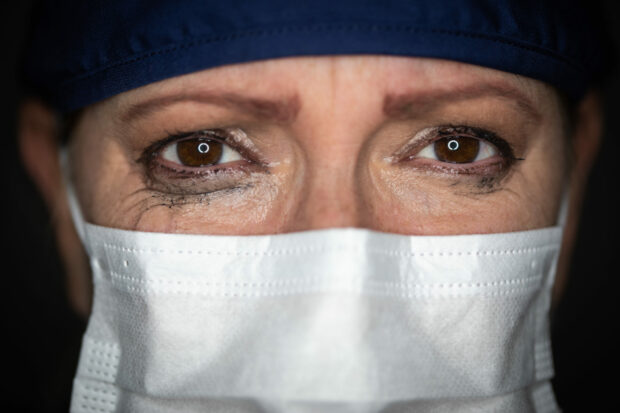HOME | ABOUT US | MEDIA KIT | CONTACT US | INQUIRE
HOME | ABOUT US | MEDIA KIT | CONTACT US | INQUIRE
Drop in nursing-school enrollments has hospital executives prepping for a more competitive talent landscape ahead.

PUBLISHED JUNE 27, 2023
For more than a decade, hospital executives have been ringing alarm bells about a looming shortage in the physician ranks as the first wave of Baby Boom-age doctors wrapped up their careers. For the past 3-1/2 years, those same executives have lamented the thinning of the nursing ranks as pandemic-related stresses prompted nurses to abandon their careers en masse.
Now, from the other end of the health-care talent pipeline, a new threat: While U.S. medical-school enrollments of physicians have increased significantly in recent years, up 5.8 percent since 2018, nursing numbers have broken the opposite direction—hard.
That’s the case as well in Missouri and Kansas. Across three dozen nursing schools in the two-state region, enrollment fell from 22,268 in the fall of 2021 to 19,339 a year later—a drop of 2,929 students, or nearly 13.2 percent.
In a single year. Worse, those numbers are down from 25,355 as recently as 2019, pushing the total decline over one four-year cohort to 23.5 percent.
Nursing school officials say the drop has left current levels closer to historical norms. But health authorities have been concerned for years that historical norms weren’t going to be enough. The aging cohort of Baby Boomers—the largest generation in U.S. history when they started showing up—will require significantly higher numbers well into the future.
“In 2020, when the COVID-19 pandemic hit, many nurses were either laid off or experienced increased burnout, leading them to leave the nursing profession altogether,” said Mykale Elbe, nurse-practitioner program director for Maryville University of St. Louis, by far the two-state region’s largest nursing school.
“This is one of the major reasons why nationwide enrollment in nursing programs has returned to the ‘norm’ or typical levels,” Elbe said. Furthermore, she said, some nurses opted to transition to travel nursing due to the financial advantages and higher salaries associated with it, and “as a result, many nurses postponed their plans of pursuing a nurse-practitioner education.”
As enrollment has dropped at the University of Missouri-Kansas City, “we have been evaluating that, and continue to,” said Casey Bauer of the School of Nursing and Health Sciences. “It is a cluster of variables.”
Among them, she said, were higher numbers of high school students whose academic progress had been delayed by the pandemic restrictions on schools, to the point where some enrolled students had to be dismissed altogether. In addition, she said, “many of our students are working nurses, and with the pandemic, if they hadn’t already dropped, began to experience burnout and school was the first to go.”
In addition, UMKC centralized its academic advising process in the fall of 2020, leading to more turnover, then retention challenges. The final factor was a reduction in staffing for recruitment, admissions and advising, which has recently been addressed with new resources. “We’ve been working hard to rebuild our numbers,” Bauer said.
Reversing the trends will not be easy, nursing professionals say.
“One of the most significant challenges confronting nursing programs, and health-care programs in general, is the availability of clinical placements,” said Elbe. “It is crucial for students to gain hands-on patient experience, but the decreased number of health-care providers has made it increasingly difficult for nursing programs to secure suitable clinical rotations for students.”
That, in turn, has created a strain on all nursing and health-care programs, she said, and it’s increasingly difficult to find appropriate clinical opportunities for students.
The good news for hospitals is that the turnover spike of 2020-21 appears to have leveled off. That’s the case at University Health, where Amy Peters, chief nursing officer, has seen the figurative bleeding stop.
Huge pay increases offered to traveling nurses during the pandemic lured many away from hospitals, she said, but that work isn’t without demands of its own, and some tempted by the higher pay are coming back. So too are some who felt the need to step away from the stress entirely, but weren’t willing to shut out the call to serve that led them to nursing.
Those developments, Peters says, “have been fantastic. We’ve hired quite a few nurses back into our nursing work force, which is slowly helping put our work force back together.”
University Health has also expanded or implemented new programs, working with other universities, to recruit students to the profession and give them clinical tools and other skills to move into career tracks.
“These are tiny steps forward to fill the pipeline, but the schools are hurting,” Peters says. “I believe interest in careers in nursing exists, but the challenge is a shortage of faculty in schools of nursing to help teach students. … We are trying to be creative in what we do to support the program, establishing a foundation that contributes to retention of those nurses in the long run.”
Perhaps the best defense against current trends in nursing-program enrollment is a good offense, in terms of creating conditions where nurses want to be part of the team.
“We have built a culture of nursing excellence and fostered a positive working environment that attracts nurses to our hospital,” said Sarah
Oakley, vice president and chief nursing officer at North Kansas City Hospital. “To help recruit new graduates, we have created a strong nurse residency program and partner with nursing schools to offer clinical rotations.”
The hospital recently received news that it had been designated once again as a Magnet hospital by the American Nurses Credentialing Center, she noted, and the hospital believes in empowering nurses to manage their practice through shared decision-making and NKCH’s Shared Governance Councils. The collective work of its nurses, she says, is “the reason we continue to be an employer of choice for the area’s best nursing talent.”